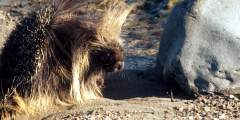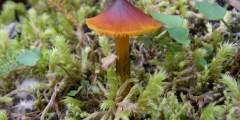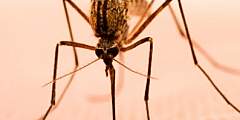Explore the Wild World of the Copper River Delta. In this Audio Guide, you'll get to learn about carniverous plants, mushrooms that hunt their prey, and find out why Cordova is one of the best places in the world to see migrating shorebirds.
Show Map
Guide Segments
Sandhill Cranes migrate through the Copper River Delta with a brief stop-over and rest at Hartney Bay in the spring and fall. Anywhere along the paved road at Hartney Bay from the bridge to the end of the paved road is a great place to see these magnificent birds.
Many species of birds migrate each year, but do we really know why? Do they migrate because of food scarcity or for breeding purposes? Learn about some of the possibilities. Hartney Bay in early May is dominated by large flocks of various shore birds as they head north to breed in Alaska.
Every year, millions of shorebirds migrate from South America into Alaska where they stop to rest and feed on the Copper River Delta mud flats at Hartney Bay. Located about 5 miles south of Cordova near the end of Whitshed Road, the mudflats are host to thousands of Western Sandpiper during high tide during the first several days of May each year. Additionally, the Copper River Delta near Alaganik Slough is an excellent location to find… ...more
Trees that are stressed due to weather, disease or insects are more likely to produce large growths called burls, or galls. Some artists will take these burls and make beautiful decorative bowls out of them. If you want to see some great examples of burls, hike along the Heney Ridge Trail. Approximately 2 miles from the trail head and a few hundred yards after crossing the large log bridge, you will find an area where several spruce trees on… ...more
Those fragile crusty gray lichens, favorite food of Caribou and often found growing on rocks in the dryer and higher areas around Cordova and the Copper River Delta, are fascinating creatures, actually symbiotic fungi-algae. The area around the top of the rocky outcrops at the end of the trail on Heney Ridge is an excellent location to study these interesting organisms.
Learn about a unique invertebrate organism that lives in all oceans of the world including areas around Cordova and the Copper River Delta, the Tunicate! An excellent place to look for tunicates, or “sea squirts” as they are commonly known, is on the edge of the docks just below waterline. The docks in the Cordova boat harbor have many species of these sometimes colorful but tiny organisms.
This program is part 1 of a 2 part program and looks at Eyak Lake, a prime salmon spawning area located within the Cordova city limits. During the many years of Cordova’s history, construction and other uses have affected the drainage patterns and erosion of the lake affecting salmon spawning habitat. Signs of lake erosion and habitat destruction can be seen when driving along Power Creek Road and the Copper River Highway near Mavis Island. ...more
Bats, though commonly thought of as elusive creatures, are regularly seen around Cordova in the summer and fall and can be seen in the evening as they flit around catching pesky mosquitoes and other insects. The area around Skater’s Cabin on Power Creek Road and other locations along the road are good locations to look for bats. And if you have a bat in your house, learn how to remove them without injury to the bat or the person.
A forest isn’t just about the trees! The forest floor is home to countless tiny critters, many of which have made unique adaptations to survive in the forest around Cordova. Most any trail in and around Cordova and the Copper River Delta will have an abundance of these tiny inhabitants living in the forest litter and moss at your feet. The trail head starting at Skaters Cabin on Lake Eyak will take hikers through dense forest up to Crater Lake… ...more
Bull kelp has made amazing adaptations to survive in the harsh Gulf of Alaska environment. It is one of the fastest growing plants in the world, and can grow to 100 feet in length. It is found around deeper water shorelines and often washed up on beaches after storms. The area close to Orca Cannery is an excellent place to tide pool and look for seaweeds, including bull kelp.
The European Black Slug is a recent invader into Alaska and Cordova. Find out how to deal with the black slimy pest and why it’s bad for native species and the residents in the area. They seem to be prolific around hiking trails and on roads like Power Creek Road.
While most people have probably heard of brown and black bears, not everyone knows that in Alaska we also have white and blue bears! Black and brown bears can be found most anywhere on the Copper River Delta with black bears passing through Cordova on a regular basis. One of the best places to see black and brown bears is during the salmon spawning season on Power Creek near the culverts under the road. Salmon spawning along the road attracts… ...more
Learn about the amazing attributes of the Bald Eagle and how they live. Eagles are found throughout most of Southcentral Alaska and are quite prolific in and around Cordova, especially the Copper River Delta. Bald Eagle nests can sometimes be seen along the road while driving to Childs Glacier, 52 miles from Cordova. They also congregate where spawning salmon are found. The Power Creek road area located just a few miles from Cordova has… ...more
In part 2, we will look at the proposed changes and restoration to various locations around Eyak Lake. The project includes replacing many inefficient culverts with fish friendly access culverts for spawning salmon and a short bridge segment near Mavis Island to improve sediment and turbidity formation along the shore where salmon spawn. Signs of lake erosion and habitat destruction can be seen when driving along Power Creek Road and the… ...more
Sundews are amazing carnivorous plants that live in poor soil conditions and catch insects in an ingenious way to supplement their needs for nitrogen and other nutrients that the surrounding soil lacks. Hiking in areas where the ground is wet and spongy or boggy, you will likely find the tiny carnivorous plants waiting for their next insect meal. Look for a small plant growing close to the ground with bright red leaves the size of a pencil… ...more
Fall time is beautiful anywhere in Alaska, but the changes in the area around Cordova and the Copper River Delta are truly breathtaking. Learn about the insect activity that takes place in this season with a detailed look at insect mimicry and a harmless bee look-alike called the flower fly. These insects are usually found in the autumn in areas with flowering plants including people’s gardens and yards and where ever flowers abound like… ...more
Porcupines, often misunderstood creatures, can be seen most anywhere in the forests around Alaska including Cordova and the Copper River Delta. In this segment you will learn about the history, habits and lifestyle of these interesting animals. A good place to look for porcupines is along the edge of side roads out on the Copper River Highway such as the Sheridan Glacier Road.
There are many types of fungus and mushrooms that can be found in the fall around Cordova and the Copper River Delta, including one that actually hunts it’s prey! Hiking in the fall along any trail around Cordova or on the Copper River Delta will produce many species of fungus and mushrooms. Driving to the end of Sheridan Road to the picnic area on the left side of the road is a great way to see many species.
The amazing iceworm can be found living on the surface of icebergs under very harsh conditions. These worms live in such harsh environments that NASA is studying them to try to understand how life on other worlds might adapt to seemingly uninhabitable conditions. The best place to find these tiny animals is on the surface of ice and icebergs near Sheridan and Childs Glaciers on the Copper River Delta. Bring your magnifying glass!
Dragonflies, the official Alaska state insect, are often found around lakes and ponds hovering or perched on a long blade of grass at water’s edge. A great location to look for dragonflies is along the edge of the many ponds located along the Alaganik road on the way to the Alaganik River. Turn right at mile 17 on the Copper River Highway and travel for about 5 miles to the U.S. Forest Service boardwalk, interpretive area and boat launching… ...more
Every year, autumn brings us beautiful fall colors, but have you ever wondered why the leaves turn yellow and red? Learn why as you soak up the scenery on the way out to Childs Glacier about 52 miles from Cordova by gravel road. Deciduous trees like cottonwoods, alders and willows will display the better colors of fall.
Glaciers aren’t just silent rivers of ice, slowly carving their way through the landscape. Glacial ice produces a sound called “bergy seltzer,” and a great place to hear it (and see a giant glacier) is Childs Glacier, located about 52 miles from Cordova.
Ever wonder why mosquitoes choose the meals they do? Maybe they always seem to prefer you over your friend. Find out why, and learn how to avoid getting bitten. Hiking almost anywhere in Alaska in the spring, summer and fall can provide swarms of biting mosquitoes. Areas where there is less standing water and locations with a good breeze will deter them from biting.







